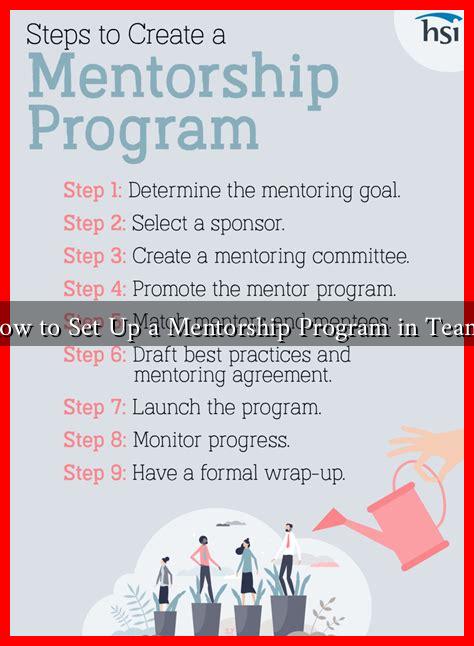-
Table of Contents
- How to Set Up a Mentorship Program in Teams
- Understanding the Importance of Mentorship
- Step 1: Define the Objectives of the Program
- Step 2: Identify the Structure of the Program
- Step 3: Recruit Mentors and Mentees
- Step 4: Match Mentors and Mentees
- Step 5: Provide Training and Resources
- Step 6: Monitor and Evaluate the Program
- Conclusion
How to Set Up a Mentorship Program in Teams
Mentorship programs have become a cornerstone of professional development in organizations, fostering growth, knowledge sharing, and collaboration. A well-structured mentorship program can enhance employee engagement, improve retention rates, and cultivate a culture of continuous learning. This article will guide you through the essential steps to set up a successful mentorship program within your teams.
Understanding the Importance of Mentorship
Before diving into the setup process, it’s crucial to understand why mentorship matters. According to a study by the Association for Talent Development, organizations with mentoring programs experience a 20-30% increase in employee retention. Mentorship not only aids in skill development but also helps in building relationships and networks within the organization.
Step 1: Define the Objectives of the Program
Every successful mentorship program starts with clear objectives. Consider the following questions:
- What skills or knowledge do you want to develop in your team?
- Are you aiming to improve employee retention or engagement?
- Do you want to prepare future leaders within your organization?
By answering these questions, you can tailor your program to meet specific needs, ensuring it aligns with your organization’s goals.
Step 2: Identify the Structure of the Program
There are various mentorship models to choose from, including:
- One-on-One Mentorship: A traditional model where one mentor is paired with one mentee.
- Group Mentorship: A mentor works with a group of mentees, fostering collaborative learning.
- Peer Mentorship: Colleagues at similar levels support each other, sharing insights and experiences.
Choose a structure that best fits your team dynamics and objectives. For instance, a one-on-one model may be more effective for personalized development, while group mentorship can encourage diverse perspectives.
Step 3: Recruit Mentors and Mentees
Recruitment is a critical phase in establishing your mentorship program. Here are some strategies:
- Promote the Program: Use internal communication channels to raise awareness about the program and its benefits.
- Set Criteria: Define what makes a good mentor and mentee. For example, mentors should have relevant experience and a willingness to share knowledge.
- Encourage Volunteering: Allow employees to express interest in becoming mentors or mentees voluntarily, fostering a sense of ownership.
Consider using surveys or applications to gather information about potential mentors and mentees, helping to make informed pairings.
Step 4: Match Mentors and Mentees
Effective matching is crucial for the success of the program. Consider the following factors:
- Professional background and expertise
- Personal interests and goals
- Preferred communication styles
Utilizing a matching tool or software can streamline this process, ensuring that pairs are well-suited for each other. For example, platforms like MentorcliQ offer features to facilitate mentor-mentee matching based on various criteria.
Step 5: Provide Training and Resources
Once pairs are established, it’s essential to equip them with the necessary tools for success. Consider offering:
- Training sessions on effective mentoring techniques
- Resource materials, such as articles and guides on mentorship
- Regular check-ins to address any challenges
Providing these resources can help mentors and mentees maximize their experience and foster productive relationships.
Step 6: Monitor and Evaluate the Program
To ensure the program’s effectiveness, establish metrics for evaluation. Consider the following:
- Feedback surveys from participants
- Tracking progress towards defined objectives
- Retention and engagement rates before and after the program
Regularly reviewing the program will allow you to make necessary adjustments and improvements, ensuring it remains relevant and beneficial.
Conclusion
Setting up a mentorship program in teams is a strategic investment in your organization’s future. By defining clear objectives, choosing the right structure, recruiting effectively, and providing ongoing support, you can create a thriving mentorship culture. Remember, the success of such a program lies in its ability to foster meaningful relationships and facilitate personal and professional growth. As you embark on this journey, keep in mind that mentorship is not just about guidance; it’s about building a community of learners who support each other in achieving their goals.
For more insights on mentorship programs, consider exploring resources from the Association for Talent Development.

